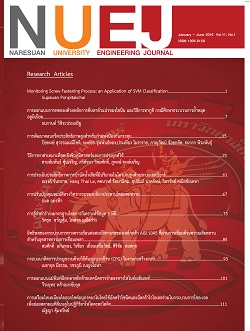การศึกษาประสิทธิภาพการบำบัดน้ำเสียไนโตรเจนด้วยระบบเอสบีอาร์
Main Article Content
Abstract
Article Details
References
S. Wu., D. Austin, L. Liu., and R. Dong, “Performance of integrated household constructed wetland for domestic wastewater treatment in rural areas”, Ecological Engineering, vol. 37, pp. 948–954, 2011.
M. Amini, H. Younesi, A. A. Z. Lorestani, and G. Najafpour, “Determination of optimum conditions for dairy wastewater treatment in UAASB reactor for removal of nutrients”, Bioresource Technology, vol. 145, pp. 71–79, 2013.
L. Miao, S. Wang, T. Cao, and Y. Peng, “Optimization of three-stage Anammox system removing nitrogen from landfill leachate”, Bioresource Technology, vol. 185, pp. 450–455, 2015.
M. Wang, and C. Park, “Investigation of anaerobic digestion of Chlorella sp. and Micractinium sp. grown in high-nitrogen wastewater and their co-digestion with waste activated sludge, Biomass and Bioenergy, vol. 80, pp. 30-37. 2015.
S. K. Lateef, B. Z. Soh, and K. Kimura, “Direct membrane filtration of municipal wastewater with chemically enhanced backwash for recovery of organic matter”, Bioresource Technology, vol. 150, pp. 149–155, 2013.
G. Markou, D. Vandamme, and K. Muylaert. “Using natural zeolite for ammonia sorption from wastewater and as nitrogen releaser for the cultivation of Arthrospira platensis”, Bioresource Technology, vol. 155, pp. 373-378, 2014.
E. Walters, A. Hille, M. He, C. Ochmann, and H. Horn, “Simultaneous nitrification/denitrification in a biofilm airlift suspension (BAS) reactor with biodegradable carrier material”, Water research, vol. 43, pp. 4461–4468, 2009.
B. K. Mobarry, M. Wagner, V. Urbain, B. E. Rittmann, and D. A. Stahl, “Phylogenetic probes for analysing abundance and spatial organization of nitrifying bacteria”, Applied and environmental microbiology, pp. 2156–2162, 1996.
L. A. Robertson, E. W. J. Van Niel, R. A. M. Torremans, and J. G. Kuenen, “Simultaneous Nitrification and Denitrification in Aerobic Chemostat Cultures of Thiosphaerapantotropha”, Applied and environmental microbiology, pp. 2812-2818, 1998.
J. Guo, L. Zhang, W. Chen, F. Ma, H. Liu, and Y. Tian, “The regulation and control strategies of a sequencing batch reactor for simultaneous nitrification and denitrification at different temperatures”, Bioresource Technology, vol. 133, pp. 59-67, 2013.
APHA, Standard Method for the Examination of Water and Wastewater, 20 ed. Washington D.C.: American Public Health Association, 1998.
G. Ruiza, D. Jeisonb, and R. Chamy, “Nitrification with high nitrite accumulation for the treatment of wastewater with high ammonia concentration”, Water Research, vol. 37, pp. 1371–1377, 2003.


